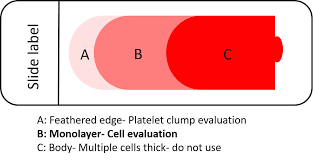Which of the following criteria is acceptable in determining the quality of a peripheral blood smear?
Covers a quarter of the slide
A well-defined edge
Covers the entire slide
A feathered edge
The Correct Answer is D
Choice A reason:
Covering a quarter of the slide is not an acceptable criterion for the quality of a peripheral blood smear. The smear should be spread across the slide in a manner that allows for proper examination under a microscope, and covering only a quarter of the slide would not provide enough area for an adequate assessment.
Choice B reason:
Having a well-defined edge is not specifically indicative of the quality of a peripheral blood smear. While the edges should be clean to allow for clear viewing of the cells at the margins, the quality is more accurately determined by the distribution and integrity of the cells on the slide.
Choice C reason:
Covering the entire slide is also not a criterion for a quality peripheral blood smear. In fact, if the blood covers the entire slide, it may be too thick to allow for proper cell differentiation and examination. A proper smear should have a gradient of cell distribution, ending with a feathered edge.
Choice D reason:
A feathered edge is the correct criterion for a quality peripheral blood smear. The feathered edge is the thinnest part of the smear and is where the cells are ideally distributed in a single layer, which is optimal for microscopic examination. This allows for the best visualization of cell morphology and is essential for accurate diagnosis.

Nursing Test Bank
Naxlex Comprehensive Predictor Exams
Related Questions
Correct Answer is B
Explanation
Choice A reason:
A hair cap is used to prevent contamination from the hair, but it is not specifically designed to protect against body fluid splashes. While it is a part of personal protective equipment (PPE), it does not provide coverage for the areas most likely to be exposed to splashes during phlebotomy procedures.
Choice B reason:
A gown is the appropriate choice for protection against body fluid splashes. It covers a significant portion of the body and is designed to prevent fluids from reaching the phlebotomist's skin or undergarments, which is essential when there is a risk of splashes during procedures like venipuncture.
Choice C reason:
Shoe covers protect the feet from contamination, but they are not typically necessary for phlebotomy unless there is a significant risk of large fluid spills on the floor. They are more commonly used in operating rooms or during the cleaning of large spills.
Choice D reason:
Sterile gloves are a standard requirement for phlebotomy to maintain aseptic technique and prevent contamination. However, gloves alone do not provide sufficient protection against body fluid splashes that may reach other parts of the body.
Correct Answer is C
Explanation
Choice A Reason:
Patient's insurance information is not typically included in the follow-up documentation of a stat result. Insurance information is relevant for billing purposes and does not pertain to the immediate clinical care or the communication of test results.
Choice B Reason:
The room number of the patient might be included in the internal documentation for logistical purposes but is not the primary piece of information required following a verbal report of a stat result. The focus should be on the communication details rather than the location.
Choice C Reason:
The name of the provider contacted is essential information in the follow-up documentation after a verbal report. This ensures that there is a record of who received the information, which is crucial for accountability and continuity of care.
Choice D Reason:
The provider's phone number is not necessary in the follow-up documentation if the name of the provider is already included. The phone number would have been used to make the initial contact, and the key information is the confirmation that the provider was reached and informed of the stat result.
Whether you are a student looking to ace your exams or a practicing nurse seeking to enhance your expertise , our nursing education contents will empower you with the confidence and competence to make a difference in the lives of patients and become a respected leader in the healthcare field.
Visit Naxlex, invest in your future and unlock endless possibilities with our unparalleled nursing education contents today
Report Wrong Answer on the Current Question
Do you disagree with the answer? If yes, what is your expected answer? Explain.
Kindly be descriptive with the issue you are facing.
